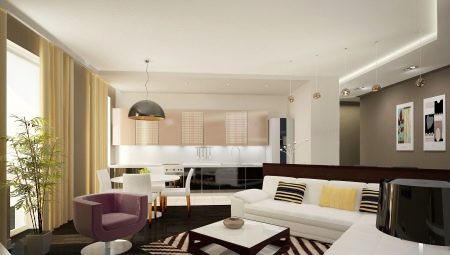From the point of view of Soviet architects of multi-storey buildings, the kitchen and the living room are, of course, different and necessarily separate. Nevertheless, many modern designers (as well as apartment owners) do not think so - it is not in vain that the studios are very popular, where there is no partition between the two rooms at all, or at least it does not constitute a full-fledged wall.
If you have at your disposal a classic apartment without such fashionable frills, this does not mean that nothing can be changed - with the proper pursuit of success, redevelopment is quite real, but it is worth considering all aspects of such a solution in advance so that the result is not unsuccessful.
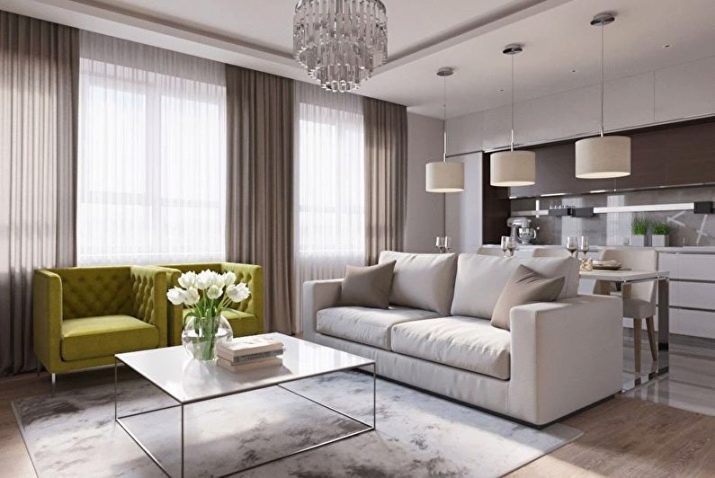
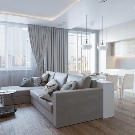
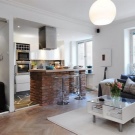
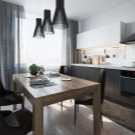
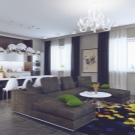
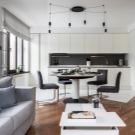
Pros and cons of combining rooms
Until now, in our country, both full-fledged studios and apartments with separate kitchen and living room are being built, which means that both layout options have both advantages and disadvantages. Going to make major changes to the concept of own housing and spend decent money on it, you simply have to soberly assess all the risks and understand why you need it.

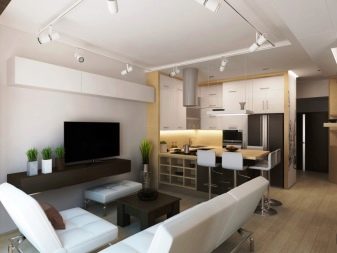

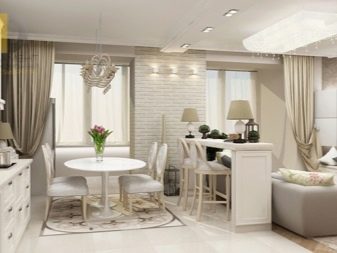
Proponents of studio apartments believe the decision to demolish the partition is very reasonable. And there are certain arguments for this.
- Convenience. Many apartments, especially old buildings, do not differ in the abundance of free space, and if more than one person still lives in a one-room apartment, space is sorely lacking.Given the furnishings, and with the current abundance of useful equipment in such a room, you just can’t get from end to end without hitting anything. In such a situation, the kitchens combined with the living room solve the problem significantly, because the space that was freed up as a result of the demolition of the wall can be filled with something useful.
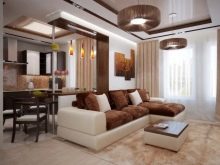
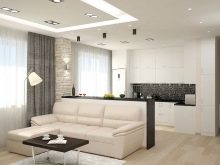
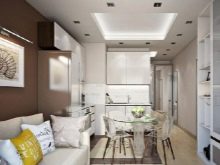
- Full control. This argument is usually pressed by parents who worry about their overly playful children. In a studio apartment it’s quite problematic to retire or hide, because mom and dad will immediately know if the baby is engaged in something potentially dangerous or bad.
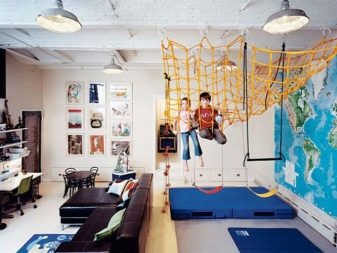

- Ease of communication. Sometimes you want to do several things at once, but your own walls interfere with this. Suppose guests came to you and you want to treat them with something tasty. You yourself are in the kitchen for culinary needs, but you can’t place them here - there is too little space. You can’t leave the kitchen at all, and moving back and forth is also risky - you don’t follow the cooking, and you don’t really participate in the conversation.
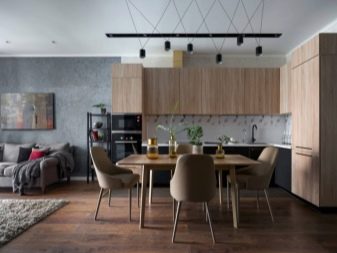
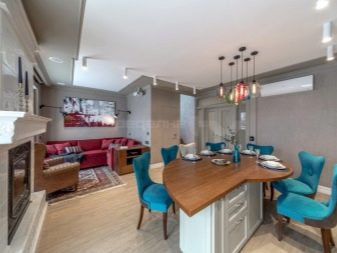
- The possibility of organizing a party. The real ability of the apartment to receive guests is not in the number of rooms or beds, but in how many people can stay in its largest room at the same time. This is understandable - any event that requires the gathering of a company does not involve dividing into separate groups that do not have a convenient opportunity to communicate with each other. The kitchen and living room, combined together, will receive five, and seven, and sometimes even more people.
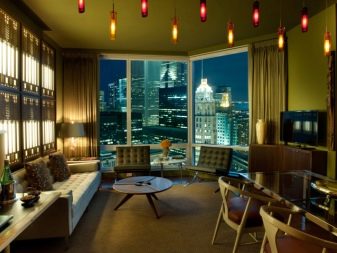

- Natural lighting. In most cases, sunlight in the apartment is considered an undoubted plus - it raises the mood, increases the temperature, and contributes to the production of vitamin D in the body. In summer, of course, it can contribute to stuffiness, but in general the climate of our country is such that for most regions natural lighting of housing is more a plus than a minus. When one of the central walls is removed inside your apartment, there are no barriers to the penetration of rays, which means that the house will be light and comfortable.
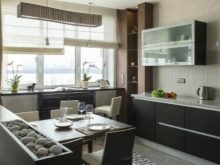
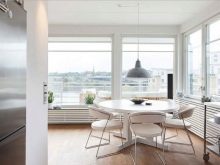
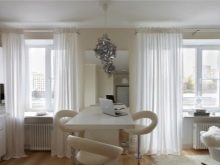
- The possibility of highlighting the dining area. You will not find a full-fledged dining area in most old high-rise buildings - the quadrature of housing is such that it simply has nowhere to place it. As a result, the same table is often used for eating, and, if necessary, for preparing it, which is not always convenient for households. The combination of the two rooms increases the amount of free space, and it is in the area of the former wall that you can put a table between them, which is located as convenient as possible for delivering food from the kitchen, but still quite far from the working area.
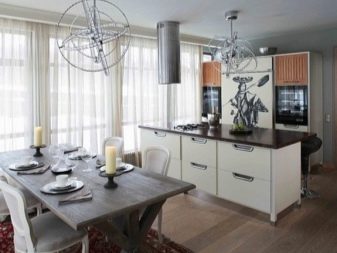
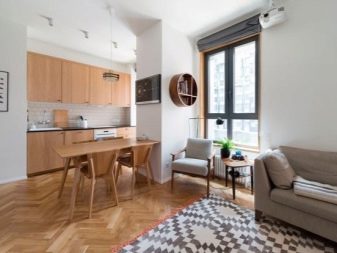

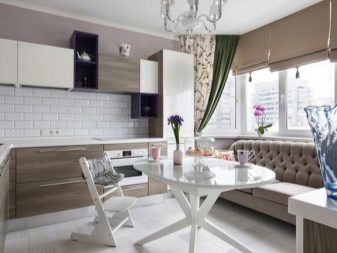
- Easy access to entertainment. Everyday cooking gets boring sooner or later, and the home chef wants to entertain themselves with something else interesting, besides culinary exercises. For these purposes, watching TV or listening to music would be well suited, but all the appropriate equipment is usually located in the living room - where they most often receive guests and relax. Despite the development of modern technologies, the smartphone is still not able to fully solve even such problems - its screen is too small, and the speakers are rather weak.
If you’re tired of having to choose between your favorite TV series and daily cooking, and there’s no chance of buying more equipment due to lack of money or space in the kitchen, just remove the wall and use the gadgets in the living room.
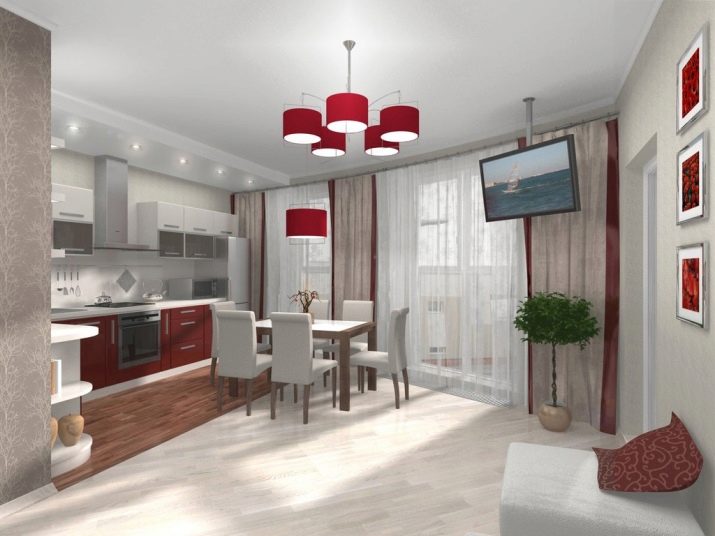
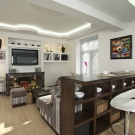

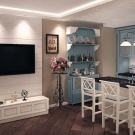
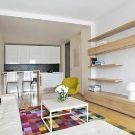
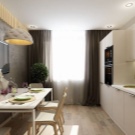
If you just realized that the wall between the kitchen and the living room has always been superfluous in your apartment, do not rush to conclusions. The disadvantages of redevelopment are less, but they are.
- Smells and noises throughout the apartment. The kitchen is a specific room. Not in vain, because it is usually fenced off from other rooms - while there is someone there, others may interfere with the clinking of dishes, splashing water and specific smells.While you live alone and there are no other people in your apartment, this may be the norm, but if you are at least two, you will have to somehow combine the schedules, because it is not very convenient to do culinary exercises in the room where someone is sleeping or trying to concentrate.
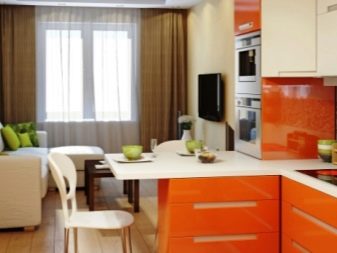
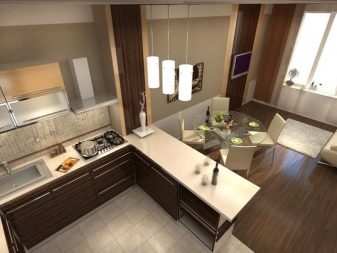
- Bureaucratic difficulties. It’s good if you started restructuring in your own cottage, which you yourself built and planned in such a way as to potentially re-plan it in the future. But even in this case, the regulatory authorities may require that you obtain the documented permission of a specialist to demolish a wall. In an apartment building, such a procedure will be mandatory, because the partition that bothers you can easily turn out to be bearing, and its demolition can bring down the whole building.
In addition, almost any communications operations require special permissions, so transferring a sink or stove may require your efforts in controlling authorities, and it is not a fact that permission will be obtained.
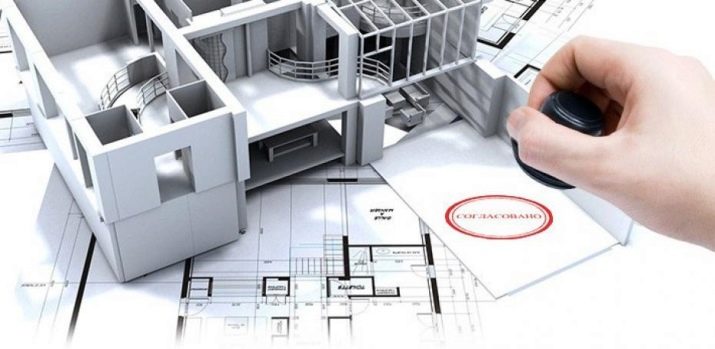
- The need for special finishes for the living room. The kitchen is known as one of the most extreme places in the apartment - there is constantly dirt, grease, water and steam, complex cleaning chemicals and temperature extremes, the same ingesting odors. All this makes you choose finishing materials from a limited circle of the most reliable. By combining the kitchen with the living room, you automatically create for them the general conditions that require sustainable decoration for the former living room as well. This not only limits you in the flight of design imagination, but also confronts the fact that each repair of a living room can now be more expensive than before.
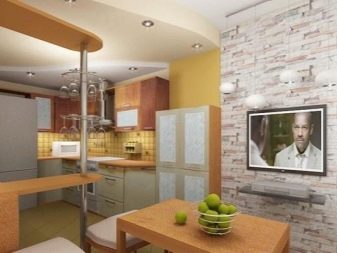
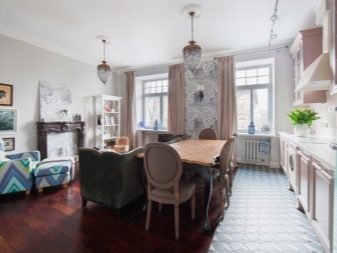
- The need to diligently monitor cleanliness. There can no longer be any talk of leaving unwashed dishes or crumbs on the kitchen table in the sink - they will inevitably spoil the image of the living room.
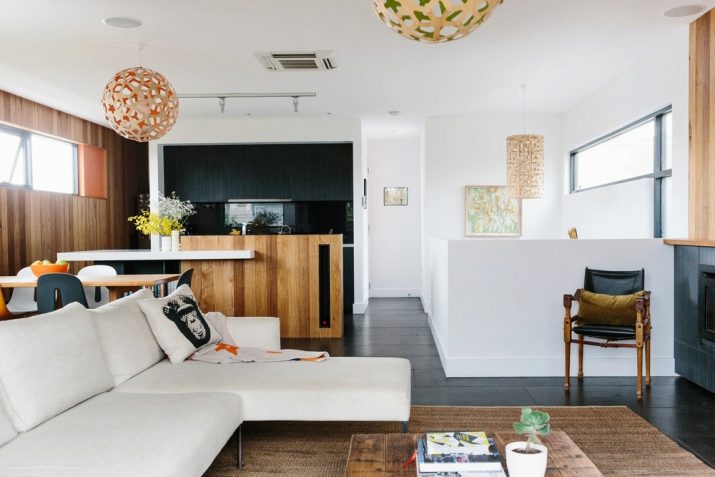
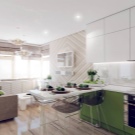


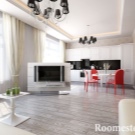
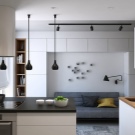
The subtleties of planning
The demolition of the capital partition to create a single kitchen-living room - the task is not so simple as to ignore the preliminary creation of the project. The cost of all the work is quite high, so you will not have an infinite number of attempts to achieve an acceptable result.
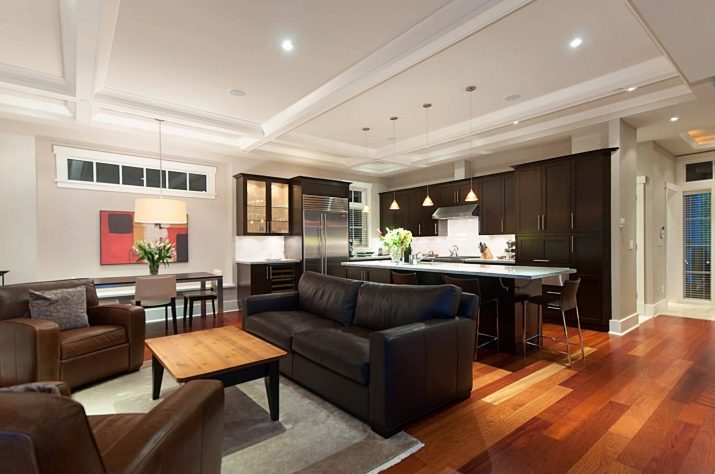
If your apartment as a whole is small-sized, and you can only get in there with considerable work, you should not expect that a simple demolition of the partition in one fell swoop will solve all the problems. In this case, it is worthwhile to focus on creating a hotel-type space, when both the kitchen and the living room have all the furniture and appliances necessary for everyday life, but all the "surplus" that cannot be used day by day should be eliminated from the project. Only in this case the difference will be noticeable.
The addition of numerous new furniture elements is allowed only in large apartments, while in close ones you risk driving yourself into even greater cramped conditions than before.
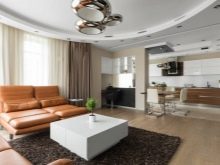
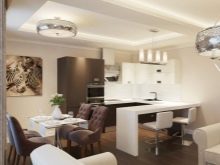
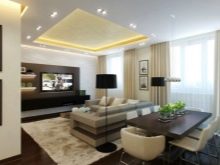
remember, that the best separator for areas in tight spaces is a table or bar. To it, the inhabitants and guests of the apartment will be able to get hooked both from the side of the kitchen, and from the side of the living room, due to which the problem of a separate dining area will be completely solved, and there will never be too many people in the kitchen. A separate dining area in the full version is usually allocated only if the resulting room seems too large and uncomfortable without it.
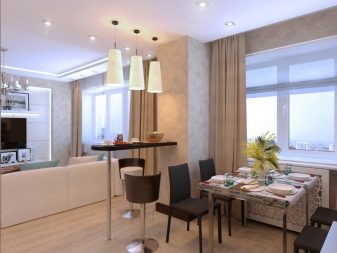
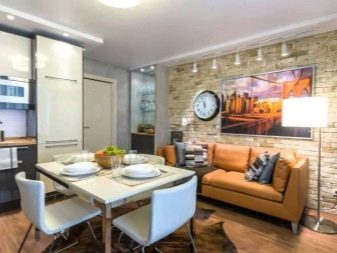
Zoning space
The combination of the hall and the kitchen into a single space involves the removal of the wall, but does not mean the complete merger of the two rooms. You must admit that a comfortable rest after work or a night's sleep does not go well with a sink and a gas stove - you want to cook directly in the kitchen, and relax and receive guests in the living room.
For this reason, the kitchen, moving into the living room, is usually divided by decoration into functional areas. These are most often distinguished by three: the actual kitchen area for cooking, a living area for relaxing and receiving visitors and a dining room - some intermediate section where it is customary to dine.

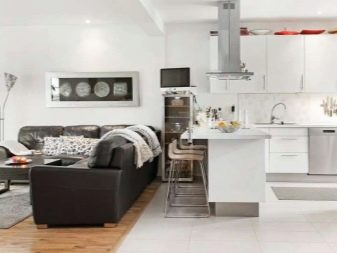
If even after the demolition of the partition, the kitchen connected to the living room has not become spacious enough, theoretically, you can sacrifice the dining area. This is done in different ways: someone who lives alone and is not used to eating at home can completely abandon it, another owner will replace a full-fledged dining area with a modest bar counter in the occupied space, the third will organize a meal area as part of the living room, without allocation in a separate zone.
Regardless of whether there are two zones in your combined room or three, you need to clearly show where one room ends and another begins. For this, usually several methods are used at once.
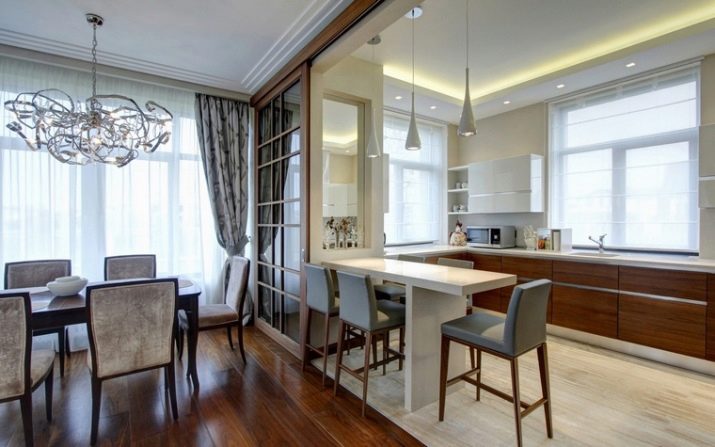
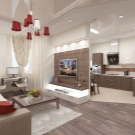
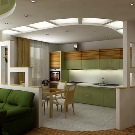
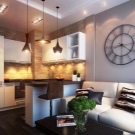
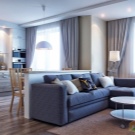
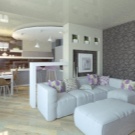
- Furniture in the form of a divider. The same table or bar counter perfectly separates one from the other, and at the same time they solve the problem of organizing the dining area. In addition, a sofa or armchairs, as well as a wardrobe can be placed on an imaginary former wall - this increases the comfort in the living room and reduces the overview of the kitchen for those who are sitting, but you can communicate “through the wall” if you wish. Of interesting options for a separator, consider an aquarium or tall green spaces in pots.
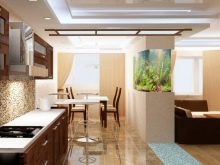
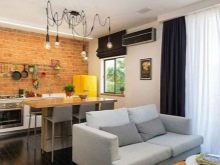
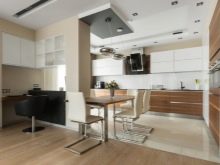
- False walls, racks, arches. Suitable as a separator, for example, a rack from floor to ceiling - there can be books, utensils, the same aquarium, while some of the through shelves can be left intentionally empty. A perforated partition with an intricate pattern at the same time hides the details of cooking from those who are sitting in the living room, but not completely, without interfering with the contact. Some people use false walls to imitate an arch, but here you need to be careful - this solution is not for all styles, but only for varieties of classics.
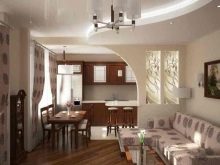
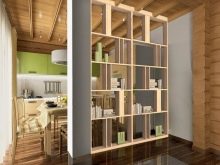
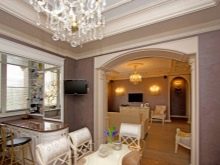
- The difference in flooring. In the kitchen, the main requirement for flooring is maximum practicality, which makes it possible to make repairs as rare as possible in harsh operating conditions. In the living room conditions are softer, and therefore you can focus on the aesthetic appeal of the finish. Although the wall between the two rooms is no longer there, the rule about choosing the floor finish still works if you draw the line between the zones far from the center of the working area. In addition, sometimes the kitchen floor is also raised relative to the living room, because it is easier to bring in communications.
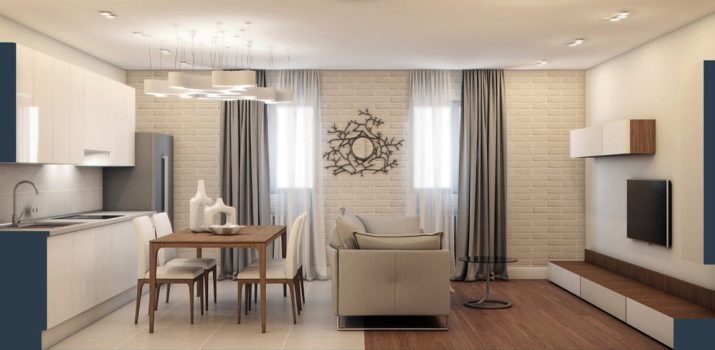
- The difference in the decoration of the ceiling. This item is generally similar to the previous one, with the only difference being that the material here more often coincides, and the main difference is the level. For the combined space, multilevel suspended or tension structures are often used, additionally highlighting the border of two zones. An additional element of the distinction may be lighting - in the kitchen, especially in the working area, it should be bright enough to perform culinary tasks, but in the living room you can focus on the softness of light and the general relaxed atmosphere.

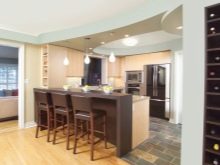
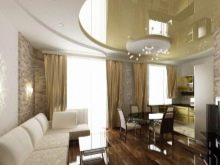
- Wide doors. Do not take the doors as a product of a purely standard size - in the sliding version, they can be so wide as to replace a full-fledged wall, but at the same time not take up too much space in the clear. With such a design move, you decide when to combine the premises, and when - to separate. If the door leaf is completely made of transparent glass, your apartment will become unique.
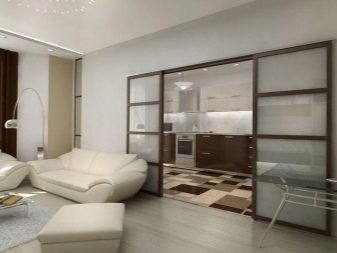
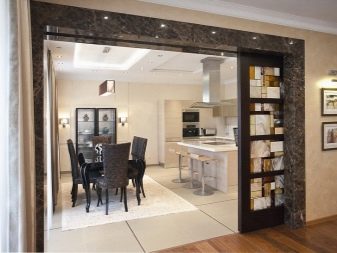
- Curtains. Instead of a dense and solid partition in the form of a door leaf, you can give preference to lighter textiles, which can also combine or divide the space at the request of the owner. Only you yourself choose what the material will be - the most dense curtain, weightless transparent tulle or something average.
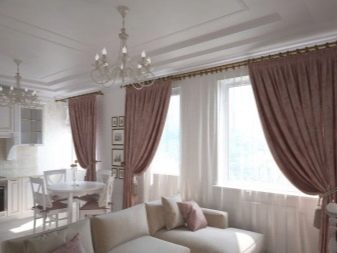
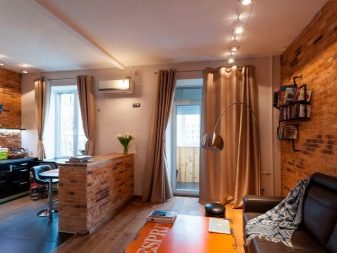
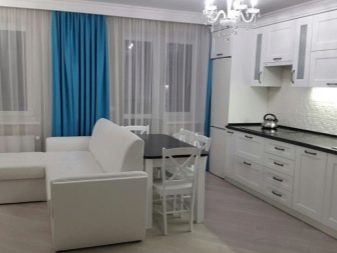
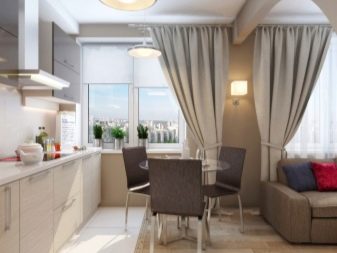
- The difference in the decoration of the walls. A classic kitchen apron is an example of how wall decoration can be combined in different colors and textures - it always stands out from the rest of the walls, is more practical and durable, but it fits into the overall picture of the interior. In the same way, with zoning of a single space, the kitchen area is finished with more resistant materials, while in the living room you can emphasize aesthetics and beauty. Differences can be further highlighted using the color or texture of the coating.
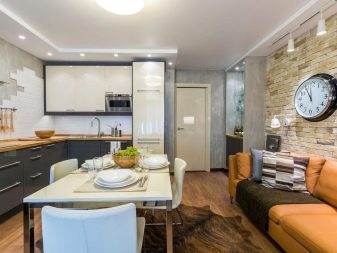
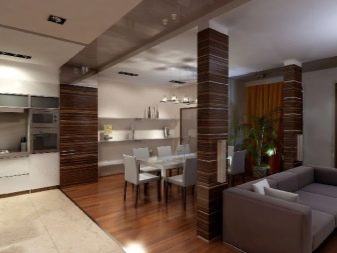
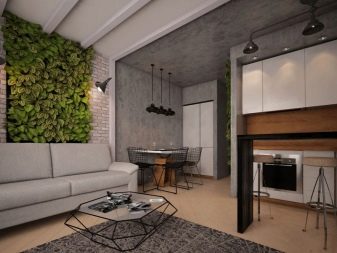

Color spectrum
Redevelopment of an apartment with a demolition of the wall usually means that the owner is cramped in the current size of the rooms. If the apartment is small, even the combination of rooms alone will not give an ideal result, and you will have to further strengthen the effect due to the correct selection of colors.
In most cases, in such a situation, light tones are chosen, since they tend to visually expand the room. Thanks to them, you will no longer feel constrained in your own home - on a bright sunny day they will add a few extra square meters to the combined room, especially if you choose the same colors for furniture.
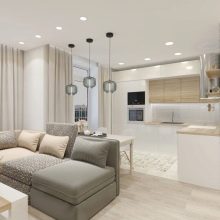
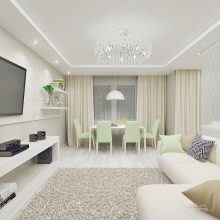
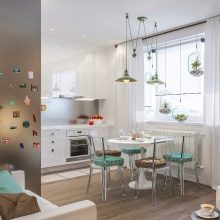
In some cases, the opposite is also assumed - the owner as a whole likes the concept of a studio as a space without extra partitions, but the resulting “gym” seems too uncomfortable for living because of its too large sizes. Such a visual defect is creeping in with the opposite course of meaning, when the decoration is done in dark colors.
At the same time, it is worth paying attention to the recommendation of psychologists who do not advise to get involved in too dark tones when decorating a kitchen - it acts depressingly on the body, and therefore you will unconsciously suffer from a lack of appetite.
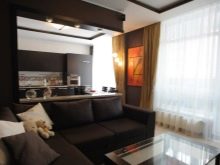
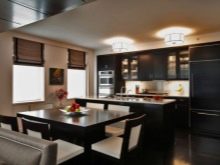

Almost certainly the kitchen and living areas will be made at least in different shades - This requires the same zoning of the room. In this case, it is logical to make the kitchen a little brighter and brighter, as this expands the traditionally cramped room and increases your activity, facilitating the digestion of food.
The living room, on the contrary, involves relaxation, and if you are not an avid activist, you can make it pastel or decorated in soft colors. This combination of colors will allow you to switch from one activity to another in a timely manner.
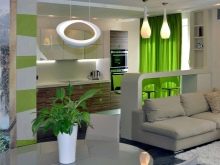
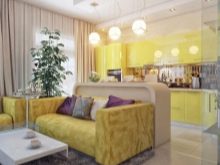
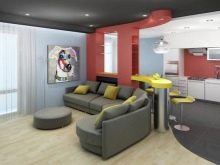
When considering combinations, pay attention to the fact that warm and cold groups of tones usually combine only with each other, without crossing groups. Most designers are generally advised to abandon the excessive contrast of bright colors. However, it is not always worth focusing on other people's advice if you know your tastes well and are able to clearly imagine what will turn out in the end. Practice shows that in some cases even the incongruous is combined, so well that one can only envy.
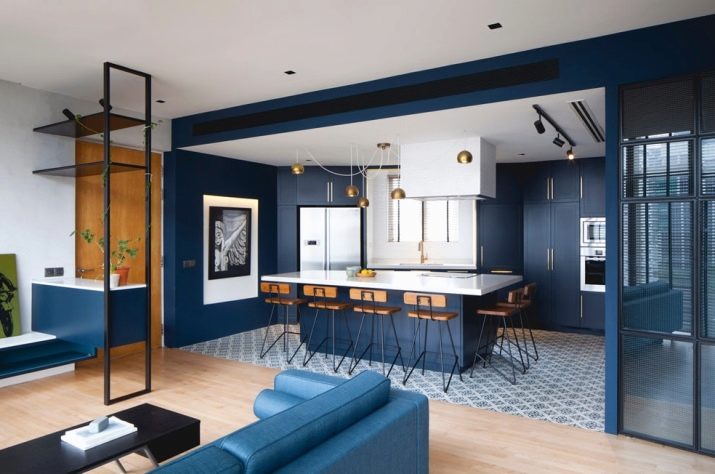
Style solutions
Determining the future design style of the connected premises, you need to consider some nuances.
- Firstly, if your apartment is far from being limited to the kitchen and living room, and in general a certain direction is already inherent in it, then it should be followed when decorating the combined space, or at least not contradict what already exists.
- Secondly, some structural features of a building or room can give a direct hint for choosing a style - for example, ceiling support beams can be hidden under a lowered suspended ceiling, but it would often be wiser to simply beat them openly in the loft style.
- Thirdly, your design fantasies should be consistent with your budget, because a half-abandoned project will look pitiful.
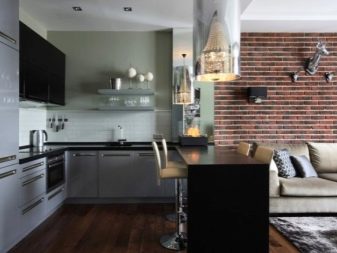
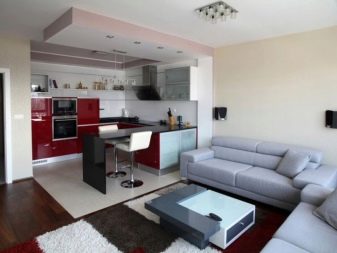
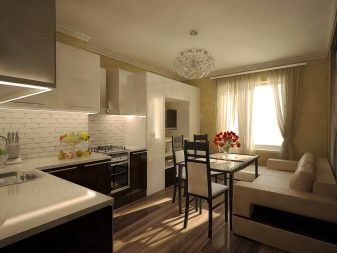
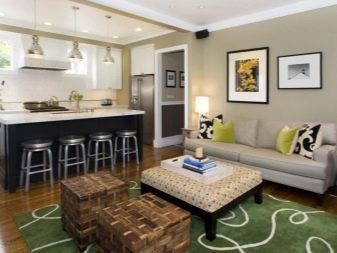
Recently, modern styles have enjoyed great success. Sometimes they are very convenient.
You do not need to invent anything with household appliances - hide or look for models in the old style, because modern equipment fits perfectly. Fans of brightness, strange color combinations and asymmetries will be able to release their innermost desires to freedom - all this is allowed by modern styles. This direction does not require a careful selection of decor, since the emphasis is largely on practicality.
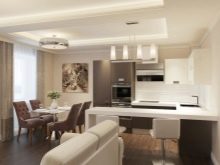

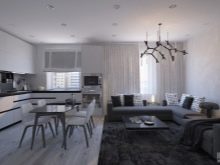
Such directions are especially often used.
- Loft imitates former industrial workshops, he does not need sophistication. Especially for him, they imitate brickwork, concrete blocks and other types of poorly processed walls, inadequately high ceilings and large windows are welcome. Here the emphasis is only on convenience, which practical people will like.
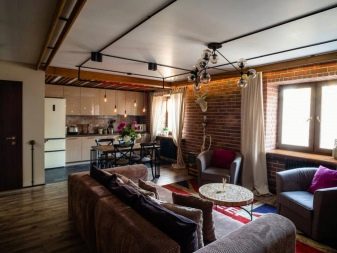
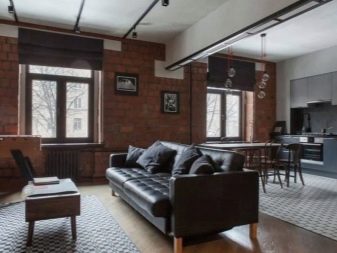
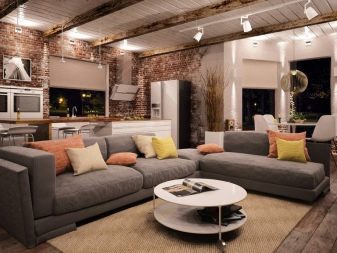
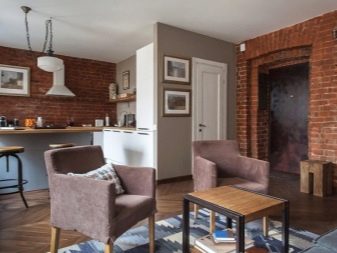
- Scandinavian style clearly shows what most of all the northerners lacked - light. The brighter the finished room will be, the more likely it will look in terms of stylistic compliance. There are no extra jewelry here - everything is in the best traditions of minimalism and practicality. When choosing materials, focus on natural raw materials, wood will be especially appropriate.
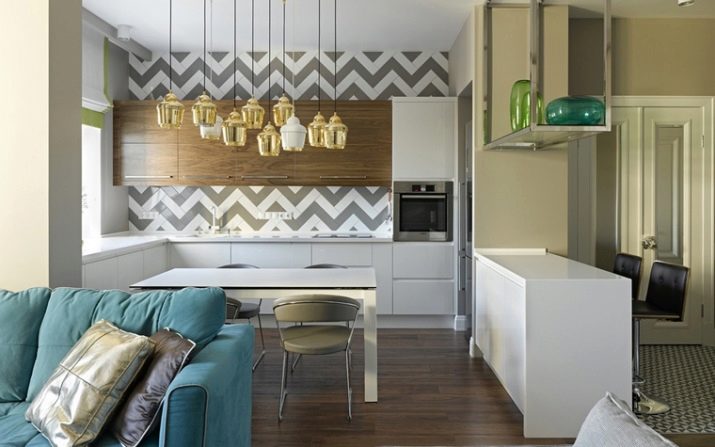
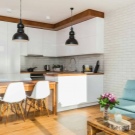
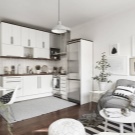
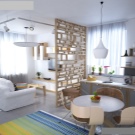
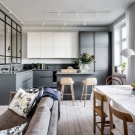
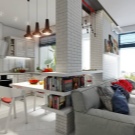
- Neoclassicism - This is a kind of attempt to replace the classic individualism of things with elements of factory production. Stucco molding and monograms, as well as mirrors, are almost mandatory things, but at the same time they can turn out to be mass-produced. Emphasis is placed on strict observance of symmetry and accuracy, but modern materials, unlike the “ordinary” classics, are not prohibited.
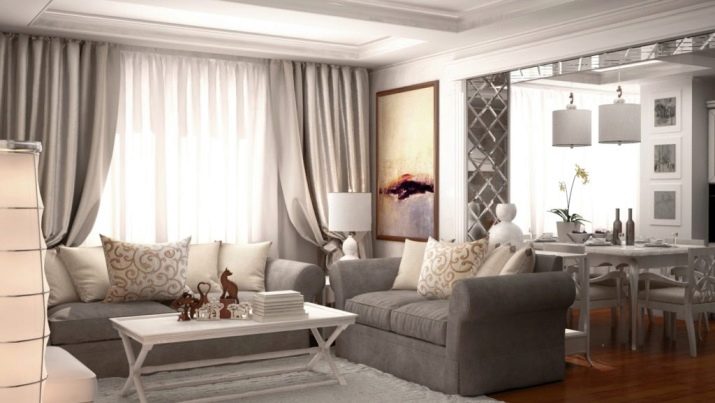
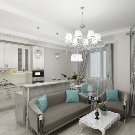
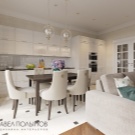
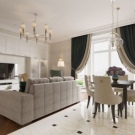
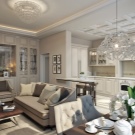

- Minimalism extremely simple - the less extraneous and impractical things, the better. He does not accept bright spots, or bizarre bends, or even protruding handles near the furniture - the eye has nothing to catch on, but this is comfort.
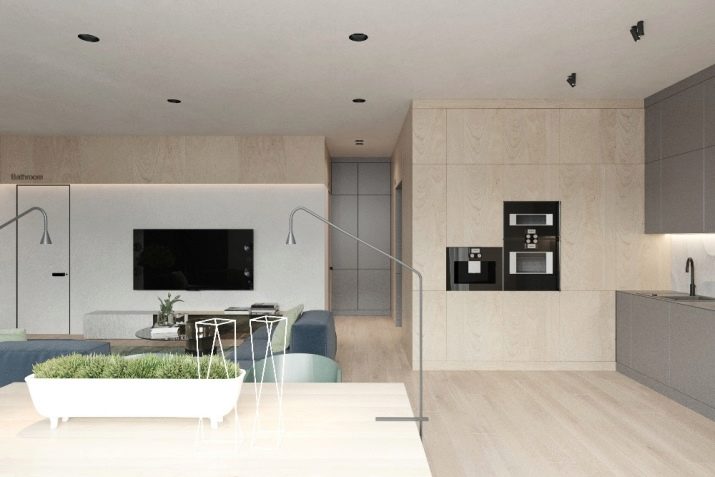

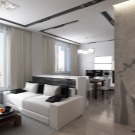
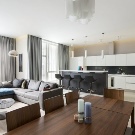
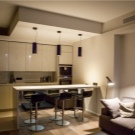
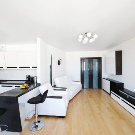
- High tech - This is the exact opposite of the classics. The outlines of the whole atmosphere should be straight, literally chopped, but no one should doubt the useful functionality of each individual item. Natural materials are not welcome here, including with textiles, but chrome surfaces will be successful, preferably monophonic with emphasis on low-key accents. The texture of the style does not imply roughness at all - the walls should have perfect smoothness.


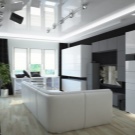

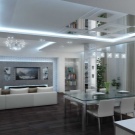
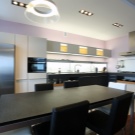
Classical trends in recent decades have noticeably surrendered, but modern opportunities allow the gourmet from aesthetics to recreate the atmosphere of any historical era. You can experiment with the following areas.
- Provence literally created for those who love French romance and tenderness. This style is a kind of rustic, only with notes of France, so do not be surprised that a lot of attention is paid to natural materials and natural light in the decoration. In terms of shades, preference is given to soft light tones, an abundance of floral motifs and textiles is considered a mandatory norm.

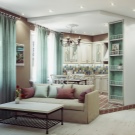
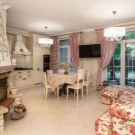
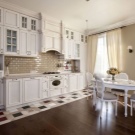
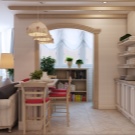
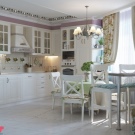
- Classic - this is thoroughness and high cost, this stylistic trend does not mean at all an imitation of the poor dwellings of antiquity, but your apartment will look like a very wealthy nobleman lives here. A key element of the style is the use of expensive materials and handmade jewelry. Do not be afraid that the classic kitchen-living room will seem an anachronism - it looks equally good, regardless of what age in the yard.
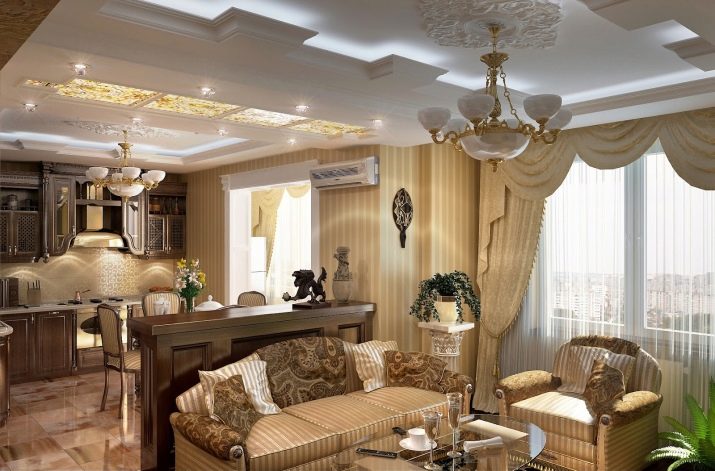

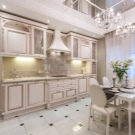
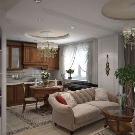
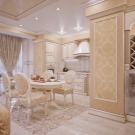
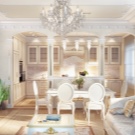
- Country, or rustic style, - This is a whole set of directions that imitate the rural situation of past times for a particular country. Provence is usually distinguished as something completely separate, but a more original owner can imitate Russian or Indian, Italian or American, Egyptian or Japanese features of decoration and decoration.
The emphasis in all cases is on traditional natural materials, and the necessary notes are made by antique and stylized textiles that are authentic for the selected country.
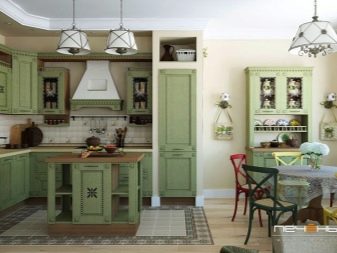
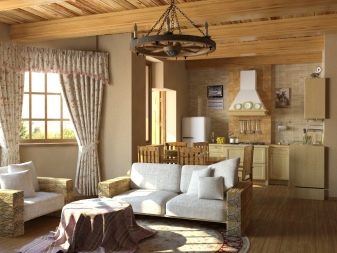
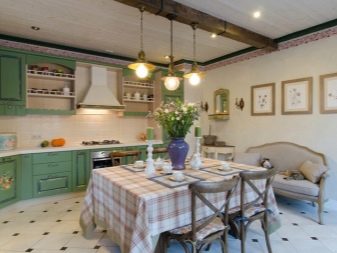
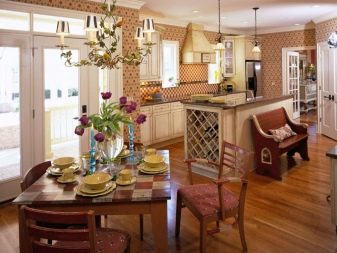
- Modern is another newfangled interpretation of the good old classics. In principle, this is still the same classic interior, with elegant things that cause delight, but with a gross violation of the principle of symmetry and correct form. Experiment with the arrangement of furniture, replace glass with expensive stained-glass windows, do not avoid optical illusions, and also - follow the combination of white and blue, and you will get the desired result. At the same time, modernism does not force one to abandon modern technologies or roughly mask them - write them so that they are not very conspicuous.
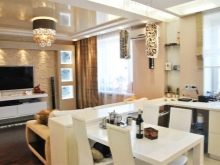
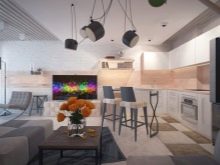
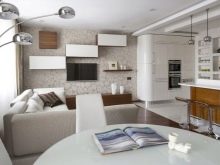
The choice of furniture and appliances
Furniture and appliances should be selected in such a way so that they do not violate the holistic arrangement of your combined premises. Experts advise not to start finishing the kitchen-living room without having a complete and holistic idea of how the ready-to-use space should look at the end. Even at the stage of selecting finishes, you should already know what furniture and appliances will fit perfectly into the interior design.
Naturally, it is worth checking in advance the availability of appropriate models in stores or the ability to order their individual production. The second option, of course, is more expensive - that is why it is so important to calculate everything in advance.

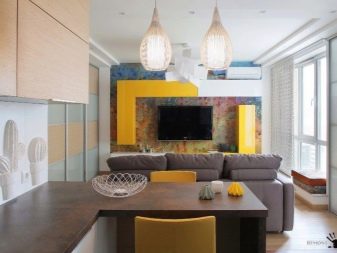
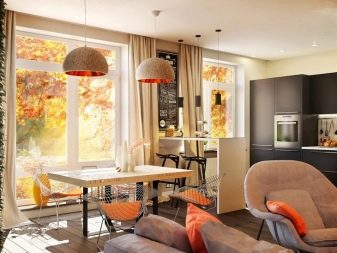
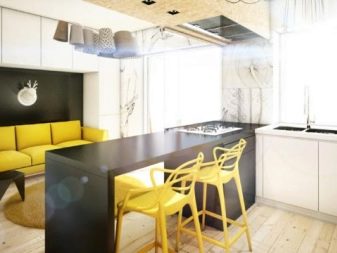
There are not so many requirements for furnishings - they must comply with the general requirements of the style in terms of colors and shapes. If you are trying to achieve Provence style with its soft lines and tones, then the chrome gray of the refrigerator will completely get out of the picture and just ruin the room.
In most cases, self-study of the future interior does not make sense - the average owner usually does not have the patience or experience to make a full-fledged project, and as a result, some detail is knocked out of an interesting overall plan. Usually, The ideal solution would be to contact a professional designer to draw up a competent project or copy what you see in the photo with minimal deviations due to the specifics of the situation or the wishes of the customer.
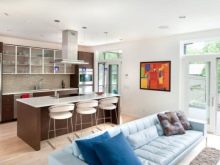

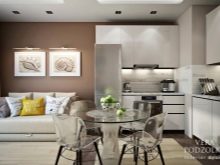
Good examples
Interior design is not a topic that can be discussed without illustrative examples, therefore, we highlight several bright samples.
- The first photo shows a stylish neoclassic. Here we see many elements hinting at the wealth of the owner - here are interesting chandeliers, a real fireplace, and the use of expensive natural materials. At the same time, there is not too much pretentiousness - just right, so that it does not interfere with comfort and is combined with modern technology.
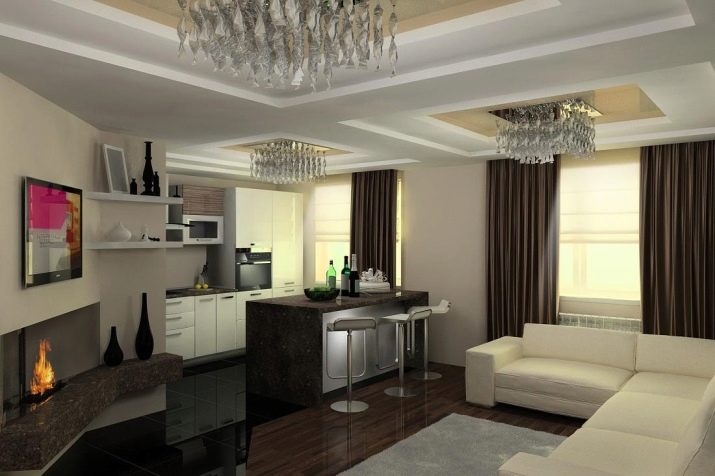
- The second example can be a great example of the Scandinavian style, assuming that it allows shades of green. There is absolutely nothing superfluous in the interior, all things are purely practical, inclusive with a tree in the corner that provides the apartment with fresh air. In combination with the abundance of natural light, such minimalism not only does not seem dry, but also evokes the elusive feeling that you are in the zone of absolute comfort.
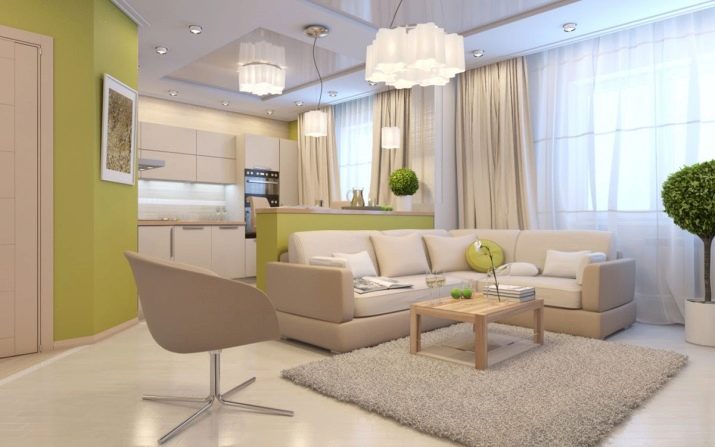
- And for those who appreciate original ideas, we have stockpiled a stunningly authentic and beautiful example of the design of a kitchen-living room in an African style. A hot, sunny color palette, imitation of a leopard skin and elaborate patterns on the walls will become an occasion for the owner to be truly proud, because his kitchen cannot be forgotten.
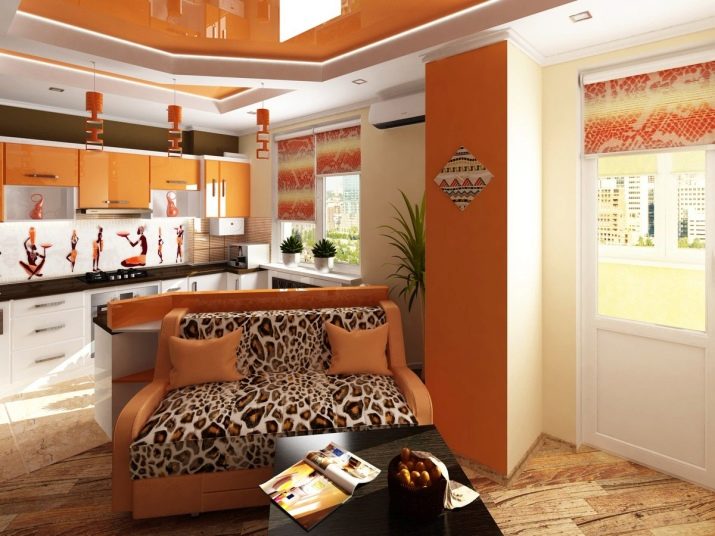
An overview of the interior of the kitchen-living room in the video below.
